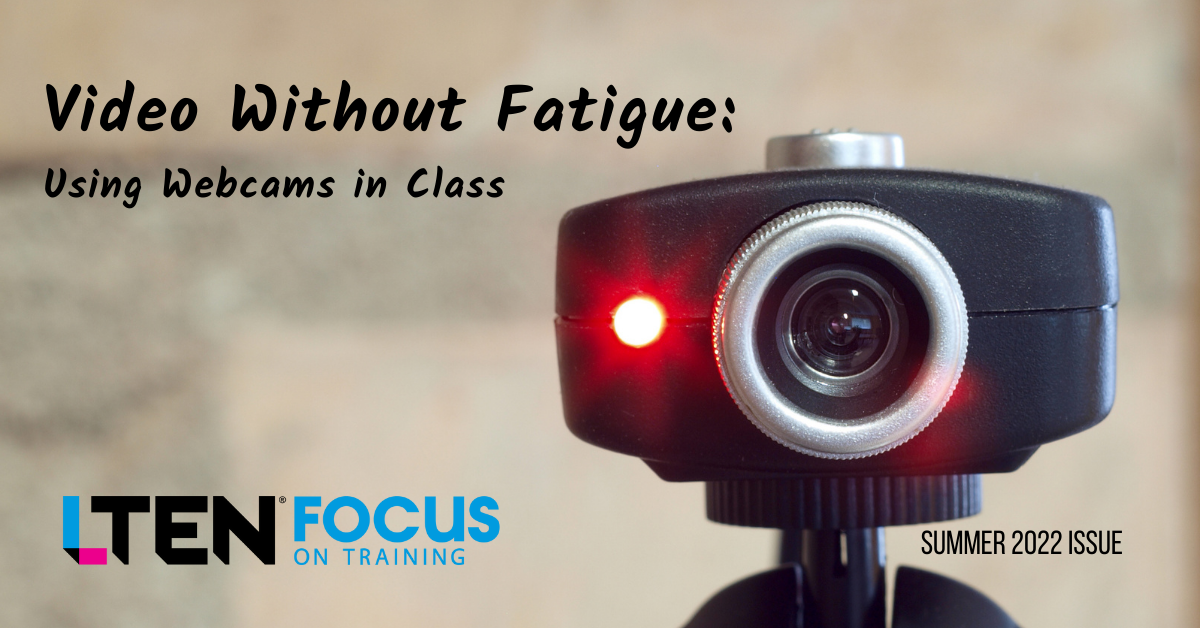
Virtual Training – Cindy Huggett, CPLP
Webcams used to be a sidenote in training. Now, the focus is on you
 There’s been much written about video fatigue due to endless online meetings. When I was first asked about it a few months into the pandemic, I initially shrugged it off but quickly realized my faulty assumption – that everyone was using video correctly. But I’ve learned that’s not the case. Video fatigue is real, and your participants are tired from being on camera for too many hours of the day.
There’s been much written about video fatigue due to endless online meetings. When I was first asked about it a few months into the pandemic, I initially shrugged it off but quickly realized my faulty assumption – that everyone was using video correctly. But I’ve learned that’s not the case. Video fatigue is real, and your participants are tired from being on camera for too many hours of the day.
Video use in virtual training is on the rise. My own research over the past few years validates it. According to the 700 global respondents in my recent State of Virtual Training survey, 70% said they are using webcams more than in previous years.
In addition, 83% of facilitators use webcams (60% the entire time, 23% for at least part of the class), and 64% of participants use them at least some of the time. Bandwidth concerns were the No. 1 reason for not using them, followed by
organizational restrictions and lack of access.
Balancing the Benefits
For many years, webcams were just a sidenote in most virtual training classes. It was (and still is) possible to have engaging conversation and meaningful collaboration without them.
They weren’t used because participant devices didn’t have them, bandwidth levels didn’t support it and technology platforms didn’t focus on video. But all of that has changed in recent years. Bandwidth is better, devices are equipped with cameras, and most online platforms not only support video, they encourage it.
So how should a facilitator balance the many benefits of using webcams without contributing to video fatigue? There are three essential elements to using video well in smallsized virtual classes:
1. Start with video on. Most virtual classroom platforms make it extra easy to enable video when joining the event. Set up the room so that when participants join, they see gallery-view video of attendees instead of presentation slides. Greet each person upon arrival and start the class with group conversation (either large group or small group breakouts). Make good use of the webcams by asking participants to connect and communicate with them. I like to use activities where participants “vote” by holding up their fingers in response to a multiple-choice question (such as “on a scale of 1-10, what do you think…?”)
By the way, be sure to let participants know in advance that for this specific class, the webcams will be on to start, so that no one is surprised.
2. Provide Instructions. Teach participants early on how to avoid video fatigue by showing them available tools that help. For example, use the platform’s “Hide Self-View” option so they can focus on others and not themselves. Show them how to easily mute and unmute themselves, so that they can quickly open and close their audio channels. In addition, avoid full-screen mode by demonstrating how to adjust viewing options and re-size windows. Finally, if participants would feel better with improvements, show how to blur backgrounds and smooth skin tone.
Of course, if your platform doesn’t include these features, consider getting creative with the available tools and/or think about add-on options that could be used. For example, I’ve adjusted lighting with temporary flashlights, changed my background by hanging a sheet on my wall and updated my appearance using a third-party camera app.
3. Be Intentional about Video Use. Just because you start with video doesn’t mean they need to be on throughout. Design your virtual class with intentional times for video-on group communication and video-off activities. Give the group breaks from video at regular intervals. Establish ground rules about video expectations and gain the group’s buy-in (for example, is it OK to eat lunch on camera?). In addition, remember that while video is always encouraged, it should never be forced, as there may be valid reasons for a webcam to be off.
In my experience when you use cameras with intention instead of haphazardly, then participants will be much more likely to open their cameras, to enjoy the benefits of seeing their colleagues in the program.
Conclusion
Give these three elements a try in your next virtual class and notice how the environment changes. Participants are likely to have increased engagement and be more open to interacting with their peers.
This positive effect makes it more likely to achieve the program’s desired outcomes and learning results.
Cindy Huggett, CPTD, is a consultant whose books include Virtual Training Tools and Templates and The Virtual Training Guidebook. Email her at cindy@cindyhuggett.com.








